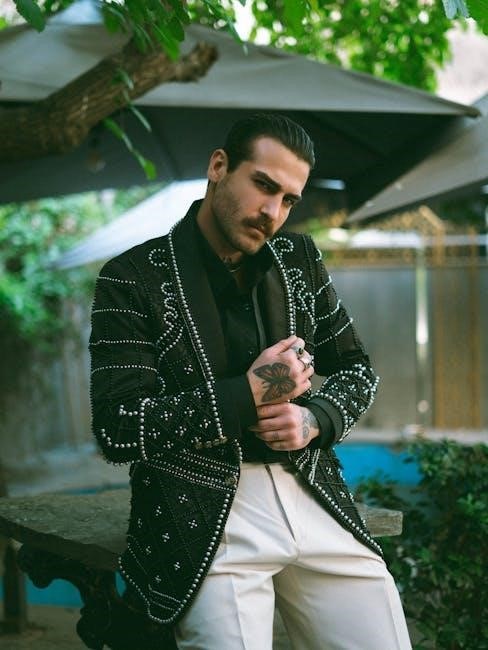Understanding suit jacket sizing is crucial for a polished look. Proper fit enhances confidence and style. Size guides help determine measurements, ensuring a tailored appearance. Body measurements and fabric type matter. Accuracy is key.
1.1 Understanding the Importance of Proper Fit
A proper fit is essential for both style and comfort. A well-fitted suit jacket enhances confidence, professionalism, and overall appearance. Proper fit ensures the jacket complements the body’s proportions, avoiding restrictive or unflattering silhouettes. It also prevents discomfort caused by tightness or excess fabric. Accuracy in sizing ensures a polished look, making it vital to prioritize precise measurements and tailored designs for optimal results.
1.2 Overview of Suit Jacket Size Guides
Suit jacket size guides provide standardized measurements to help individuals select the right fit. These guides often include charts with chest, shoulder, and sleeve lengths, catering to various body types. Regional differences exist, with US, EU, and UK sizing varying slightly. Understanding these guides ensures a tailored fit, avoiding common issues like tightness or excess fabric. They serve as a roadmap for achieving a polished, professional appearance.
Key Considerations for Choosing the Right Size
Choosing the right suit jacket size involves considering body type, fabric weight, and suit style. Proper measurements ensure comfort and a flattering fit, avoiding common sizing pitfalls.
2.1 Body Type and Suit Jacket Fit
Your body type significantly influences the fit of a suit jacket. Slim-fit jackets suit lean builds, while classic styles accommodate broader shoulders. Athletic builds may opt for tailored fits to balance proportions. Ensure measurements align with your physique for a flattering silhouette. Proper fit enhances posture and confidence, making it essential to choose styles that complement your natural shape. Accurate sizing ensures comfort and a polished appearance, tailored to your unique body type.
2.2 Fabric Weight and Its Impact on Size
Fabric weight plays a role in suit jacket sizing, as heavier fabrics like wool may require a slightly larger size for comfort. Lighter fabrics, such as linen, drape differently and might fit more snugly. Understanding the fabric’s thickness helps in choosing the right size, ensuring the jacket isn’t too tight or loose. Always consider fabric weight when measuring to achieve the best fit and comfort, as different materials can affect how the jacket sits on your body.
2.3 Suit Style and Its Influence on Measurements
Suit styles, such as slim-fit, regular, or loose-fit, significantly impact measurements. Slim-fit jackets require precise chest and shoulder measurements, while loose-fit styles offer more room. Double-breasted suits may need adjustments for chest and waist. The cut and design elements, like padding or tapered sleeves, also influence how measurements are interpreted. Always consider the style when selecting your size to ensure a flattering and comfortable fit that aligns with your body type and personal preference.
Measuring Yourself for a Suit Jacket
Accurate measurements are essential for a perfect fit. Use a flexible tape measure, ensure proper posture, and keep the tape level. Measure over lightweight clothing only.
3.1 How to Measure Chest Size
To measure your chest size, stand upright and place the tape measure under your arms, across the widest part of your chest. Keep your arms relaxed at your sides and the tape level. Ensure the tape isn’t too tight or loose. The measurement will help determine your suit jacket size, ensuring a comfortable and tailored fit. Accuracy is key for the perfect silhouette.
3.2 How to Measure Shoulder Length
To measure shoulder length, stand straight and place the tape measure across your shoulder tips. Start at one end of your shoulder and extend it to the other, keeping the tape level. Ensure the tape isn’t too tight or loose. This measurement helps determine the jacket’s shoulder fit, ensuring it aligns with your natural posture. Accurate shoulder length is vital for a balanced and comfortable suit jacket fit.
3.3 How to Measure Waist Size
Measuring waist size for a suit jacket involves wrapping a flexible tape measure around your natural waistline. This is typically just above the hip bone and below the ribcage. Keep the tape level and snug but not too tight. Breathe naturally to ensure accuracy. This measurement helps determine the jacket’s midsection fit, ensuring comfort and a tailored appearance. Accurate waist measurement is essential for achieving the right balance in the jacket’s structure.
3.4 How to Measure Sleeve Length
Measuring sleeve length for a suit jacket requires precision. Stand straight with arms relaxed by your sides. Place the tape measure at the center back of your neck, extending it over your shoulder, down to your wrist. Ensure the tape follows the natural curve of your arm. Note the length where the sleeve should end, typically just past the thumb joint. This ensures a balanced, proportional fit, avoiding sleeves that are too short or overly long.
3.5 How to Measure Body Length
To measure body length for a suit jacket, stand upright and place the tape measure at the base of your neck, centered at the back. Gently extend the tape down the spine, following the natural curve of your torso. The measurement ends just below the hip, ensuring the jacket covers your waistline appropriately. This ensures a balanced fit, neither too short nor too long, complementing your overall silhouette and style preferences.

Understanding Suit Jacket Size Charts
Suit jacket size charts provide standardized measurements for chest, waist, and length. They vary by region, with US, EU, and UK sizing differing slightly. Accurate interpretation ensures proper fit and style alignment, helping you choose the ideal jacket size based on your body measurements and preferred cut;
4.1 Differences Between US, EU, and UK Sizing
US, EU, and UK sizing systems differ slightly in measurements and labeling. US sizes are more flexible, while EU sizes are precise and based on centimeters. UK sizes align closely with EU but often vary slightly in cut and fit. Understanding these regional differences is key to selecting the correct size. Always refer to the specific size chart for the region or brand to ensure accuracy and avoid discrepancies in fit.
4.2 How to Read and Interpret Size Charts
Reading size charts requires aligning your measurements with the provided data. Start by identifying your chest, shoulder, and waist measurements. Match these to the chart, ensuring they correspond to the jacket’s style and fit. Pay attention to labels like “Slim Fit” or “Regular Fit,” as they affect sizing. Double-check the numbers to confirm accuracy. If unsure, consider the brand’s sizing tendencies or consult customer reviews for fit insights to ensure confidence in your selection.
4.3 The Impact of Jacket Style on Sizing
Different jacket styles significantly influence sizing. Slim-fit jackets require precise measurements due to their tailored design, while regular-fit offers more flexibility. Loose-fit styles accommodate broader shoulders and waists. Fabric weight and jacket length also vary, affecting how measurements translate to size. Always compare your measurements to the specific style’s size chart, as sizing can differ between slim, regular, and loose-fit options. Consider fabric thickness and intended use to ensure the best fit.

Common Fit Issues and How to Avoid Them
Common fit issues include shoulder misalignment and sleeve length discrepancies. Ensure proper measurements and consider fabric thickness. Tailoring can address minor sizing inaccuracies for optimal comfort.
5.1 Identifying a Too-Tight or Too-Loose Fit
A too-tight jacket restricts movement and may cause fabric strain, while a too-loose fit lacks definition. Check if the chest drape lies smoothly and shoulders align properly.
Ensure one hand fits comfortably in the chest pocket. If the jacket pulls open or sags, adjustments are needed. Accurate measurements and fabric choice prevent such issues, ensuring a balanced, tailored look for comfort and style.
5.2 Adjusting for Shoulder Fit
The shoulders are a critical factor in jacket fit. Shoulder pads should align naturally with your body, neither too wide nor too narrow. If the pads extend beyond your shoulders, the jacket is too large. Conversely, if they feel restrictive, it may be too small. Broader shoulders often require a larger size, while narrower frames may need a smaller fit. Tailoring can adjust shoulder pads or reshape the jacket for a seamless fit.
5.3 Ensuring Proper Sleeve and Body Length
Sleeve length should reach the wrist bone, allowing shirt cuffs to show about half an inch. Body length should cover the hips and align with the base of the thumb when arms hang naturally. Proper fit ensures a balanced look, avoiding a boxy or overly tailored appearance. If adjustments are needed, tailoring can refine the length for a polished finish. Correct proportions are vital for both style and comfort in a suit jacket.
The Role of Fabric in Suit Jacket Fit
Fabric weight and texture significantly impact fit. Thicker fabrics may require sizing adjustments, while lighter materials drape differently. Layering and fabric stretch also influence comfort and appearance.
6.1 How Fabric Thickness Affects Size
Fabric thickness plays a crucial role in suit jacket sizing. Thicker fabrics, like wool, may require a slightly larger size for comfort, while lighter materials, such as cotton, drape differently. Fabric weight influences how the jacket molds to the body, potentially altering measurements. Understanding fabric thickness ensures proper fit and prevents issues like restrictive movement or an ill-fitting silhouette. Always consider fabric type when selecting sizes for optimal comfort and style.
6.2 Layering Considerations for Jacket Fit
Layering significantly impacts suit jacket fit. Heavier layers like sweaters or blazers require a slightly larger size for comfort. Fabric type and thickness influence how layers sit beneath the jacket. Ensuring enough room for movement without compromising style is key. Consider your typical layering needs when choosing a size to maintain a balanced, polished appearance. Proper fit over layers ensures both comfort and a tailored look.

Alteration Options for a Perfect Fit
Suit jackets often require alterations for optimal fit. Common adjustments include taking in or letting out seams, shortening sleeves, or nipping in the waist. A skilled tailor can ensure a tailored look, addressing specific fit issues to create a polished, professional appearance. Proper alterations enhance comfort and style, making the jacket truly yours.
7.1 When and How to Tailor Your Jacket
Tailoring your suit jacket is essential when off-the-rack sizes don’t fit perfectly. If the jacket feels too tight, too loose, or misaligned, consult a professional tailor. They can adjust seams, shoulders, and sleeves for a custom fit. Consider tailoring if the jacket’s style or length needs updating. Proper tailoring ensures a polished look, enhances comfort, and extends the jacket’s lifespan. Always take precise measurements and communicate clearly with your tailor for the best results.
7.2 Common Alterations for Suit Jackets
Common suit jacket alterations include taking in or letting out the sides, adjusting shoulder pads, shortening or lengthening the jacket, and tweaking sleeve length. Collar and buttonhole adjustments are also frequent. For a perfect fit, consider narrowing or widening the lapels. Professional tailors can also reshape the silhouette or repair seams. These alterations ensure a tailored look, addressing specific fit issues. Always provide clear instructions to achieve desired results.
Choosing the Right Style for Your Body Type
Selecting the right suit jacket style enhances your physique. Slim-fit suits complement lean builds, while classic styles balance broader shoulders. Rustic or oversized jackets flatter larger frames, ensuring a tailored look.
8.1 Slim-Fit, Regular-Fit, and Loose-Fit Options
Slim-fit jackets are tailored closely to the body, accentuating a lean silhouette. Regular-fit offers a classic, balanced look, while loose-fit provides comfort and a relaxed appearance. Slim-fit suits are ideal for those with smaller frames, regular-fit for average builds, and loose-fit for broader shoulders or those preferring a more casual style. Each style ensures a flattering fit, catering to diverse body types and personal preferences.
8.2 Selecting the Best Jacket Style for Your Build
Choosing the right jacket style depends on your body type. Slim-fit jackets complement lean frames, while structured shoulders suit athletic builds. For broader shoulders, a slightly padded style balances proportions. Petite individuals benefit from shorter jackets, elongating the torso. Larger builds look sharp in two-button or double-breasted styles. Matching jacket style to body type ensures a flattering fit and enhances overall aesthetics, making it a crucial step in selecting the perfect suit jacket.
Caring for Your Suit Jacket
Proper care ensures longevity and maintains shape. Regular cleaning, storage on a padded hanger, and avoiding excessive heat preserve fabric quality and fit. Fabric-friendly practices are essential.
9.1 How to Maintain the Shape and Fit
To maintain your suit jacket’s shape and fit, store it on a padded hanger to prevent shoulder stretching. Avoid over-cleaning, as excessive dry cleaning can degrade fabric. Instead, brush off dirt and spot clean stains gently. Hang the jacket after wear to allow fibers to breathe and reset. Avoid folding or leaving it in tight spaces. Regularly checking and adjusting buttons ensures alignment. These habits preserve the jacket’s structure and extend its lifespan.
9.2 Cleaning and Storage Tips
For cleaning, spot treat stains gently with a damp cloth. Avoid harsh chemicals or excessive cleaning, as this can damage fabrics. Store your jacket on a padded hanger to maintain shape and prevent wrinkles. Use a breathable garment bag to protect it from dust and moisture. Avoid folding, as this can crease the fabric. Keep it in a cool, dry place to preserve quality. Regular brushing with a fabric brush helps remove dirt and maintain texture.

Real-World Examples and Case Studies
Real-world examples illustrate common fit challenges and solutions. Case studies highlight successful size selections, offering practical insights into achieving the perfect jacket fit.
10.1 Common Size-Related Mistakes and Solutions
Common mistakes include inaccurate measurements, ignoring fabric thickness, and not considering jacket style. Solutions involve using precise measuring tools, consulting size guides, and tailoring for a perfect fit.
10.2 Success Stories of Finding the Perfect Fit
Many individuals have achieved a flawless suit jacket fit by following size guides and tailoring tips. For example, a broad-shouldered man found his ideal slim-fit jacket by measuring accurately and considering fabric thickness. Similarly, a petite woman achieved a balanced look by choosing a tailored fit and adjusting sleeve length. These success stories highlight the importance of precise measurements, understanding fabric, and styling to ensure a confident, polished appearance.

Frequently Asked Questions
Common questions include determining the right size and fit. Do I size up or down? Can I return a poor fit? Answers vary by brand and style, ensuring confidence.
11.1 Do I Need to Size Up or Down?
Deciding whether to size up or down depends on your measurements and fit preferences. If your chest or shoulder measurements are borderline, consider sizing up. For a slimmer fit, size down. Always refer to the brand’s size chart, as sizing can vary. Layering and fabric thickness may also influence your decision, ensuring optimal comfort and appearance. Take precise measurements to make the best choice. Proper fit is essential for style and confidence.
11.2 Can I Return or Exchange a Poor-Fitting Jacket?
Most retailers allow returns or exchanges for poor-fitting jackets, but conditions apply. Ensure the jacket is in its original condition with tags attached. Return periods often range from 30 to 60 days. Check the retailer’s policy for specific guidelines. Some may require a restocking fee or charge for return shipping. Reviewing size charts and taking accurate measurements beforehand can help minimize the need for exchanges. Proper fit is essential for style and comfort, making precise sizing crucial.
Proper fit is key to style and comfort. Accurate measurements and understanding size guides ensure confidence. Tailoring options exist for adjustments. Invest time in getting it right for a perfect fit.
12.1 Final Tips for Ensuring the Best Fit
Invest time in precise measurements and consult size guides. Consider fabric weight and style impact. Tailoring is a viable option for adjustments. Prioritize quality and comfort. A well-fitted suit enhances confidence and style. Remember, accuracy in measurements ensures a polished look. Proper fit is key to making a lasting impression. Always opt for tailored adjustments if needed.
12.2 Encouragement to Take Measurements Seriously
Precise measurements are the cornerstone of a well-fitting suit jacket. A jacket that fits perfectly enhances your confidence and style. Taking the time to measure accurately ensures a polished look and avoids costly alterations. Remember, proper fit is an investment in your appearance and confidence. Don’t overlook the importance of precise sizing for a tailored, professional look that elevates your wardrobe.
Additional Resources
Explore size charts and measuring guides for precise suit jacket sizing. Utilize online tools and detailed fit guides to ensure accuracy and confidence in your selections.
13.1 Recommended Tools for Measuring
To ensure accurate suit jacket measurements, use a flexible tape measure for chest, shoulders, and waist. A full-length mirror helps verify proper alignment. Consider a height chart for precise body length measurements. For digital convenience, mobile apps like SizeUp or MySize offer guided measuring. Always double-check your measurements for consistency. Use these tools to find your perfect fit and consult a size chart for verification.
13.2 Links to Size Charts and Guides
For precise sizing, refer to size charts from reputable brands like Brooks Brothers or Ted Baker. Visit tailoring guides for detailed measurements. Use universal size charts to compare brands. Check measurement tutorials for accuracy. Access international size conversion tools to ensure the best fit. Consult multiple resources to confirm your size and style preferences.

